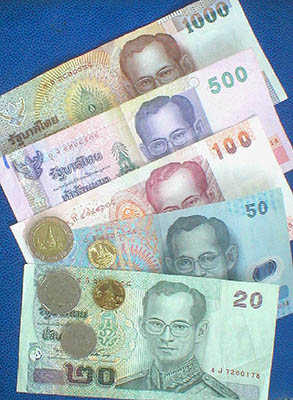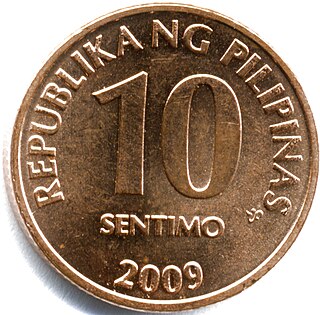Related Research Articles

The baht is the official currency of Thailand. It can be divided into 100 satang. The issuance of currency is the responsibility of the Bank of Thailand. SWIFT ranked the Thai baht as the 10th-most-frequently used world payment currency as of December 2023.
The One guilder coin was a coin struck in the Kingdom of the Netherlands between 1818 and 2001. It remained in circulation until 2002 when the guilder currency was replaced by the euro. No guilder coins were minted in the German occupation of the Netherlands in World War II.
The Thailand five-satang coin is a unit of currency equivalent to one-twentieth of a Thai baht. It was introduced in 1908 as a coin with a hole through its middle, which was minted until 1939. In 1946 the hole was removed and the new Thai monarch featured on the obverse: Rama IX. In 1996 a five-satang coin marked the 50th anniversary of his reign.
The Thailand ten-satang coin is a currency unit equivalent to one-tenth of a Thai baht. It is rare in circulation but used in banking transactions.
The one-dollar coin is the fourth-highest and fourth-lowest denomination coin of the Hong Kong dollar.

The twenty-five øre coin was a coin of the Danish krone. It was the lowest-denomination coin in the country when it was demonetised on 1 October 2008.
The five-dollar coin is the second-highest-denomination coin of the Hong Kong dollar. It replaced the five-dollar banknote in 1976.

The twenty-cent coin is a coin of the Hong Kong dollar. It is the second-smallest denomination coin in Hong Kong. There have been two different periods of usage for a twenty-cent coin: the first, round twenty-cent was issued from 1866 to 1905, and the current scallop-shaped coin was introduced in 1975.
The five-cent coin was first issued as a silver coin of .800 fineness in 1866. It had a diameter of 15 mm, thickness of 0.80 mm, weighed 1.34 grams, and had a reeded edge. This coin was minted in silver until 1935, when its composition was changed to copper-nickel. It had an extensive mintage between 1866 and 1933, with some issued in 1932–33 with a plain edge. The coin was not minted in 1869–71, 1878, 1896, and 1906–1932. The following copper-nickel denomination was identical in all aspects except the composition and weight: it weighed 1.36 grams, 0.02 grams heavier than the previous coin. This was a one-year type as it was replaced with a pure nickel coin in 1937. This time, it had a diameter of 16.51 mm, was 1.73 mm thick, and weighed 2.59 grams. This was minted until 1941, with the last issue being scarce. Unlike the very rare 1941 Hong Kong one-cent coin these are available, although were never released to circulation because of the Japanese occupation.
The Romanian one-ban coin is a unit of currency equalling one one-hundredth of a Romanian leu. It is the lowest-denomination coin of the present currency and has been minted every year since the leu was redenominated in 2005. As well as Romania, the coin has been minted in the United Kingdom (1867), Germany (1900) and Russia (1952).

The krone coin is the second-smallest denomination of the Danish krone.

The ten-sentimo coin (10¢) coin is a denomination of the Philippine peso. It was the oldest denomination under 1 peso in the country's circulation, having been introduced in 1880 during the Spanish rule of the islands until it stopped being minted in 2017. The denomination remains legal tender until the demonetization of the BSP Coin Series.
The history of Thai money used as a medium of exchange and to settle accounts before the adoption of Thai baht coins and banknotes include novel designs and forms. For Thai people, money was considered as the symbol of civilization. Currency itself reflected faith in religion, culture, the customs and traditions of each era and also serve as a record of the development of Thailand.
The New Zealand two-dollar coin is the largest-denomination coin of the New Zealand dollar. It was introduced along with the one-dollar coin in 1990. Both are made from an alloy of aluminium and brass. It is the largest and heaviest coin in circulation, weighing ten grams and measuring 26.5 millimetres in diameter. Its thickness is 2.7 mm, only 0.4 mm thinner than the one-dollar coin, thus it is the second-thickest coin in the country's circulation. Both the $1 and $2 coins are gold-coloured, and requests for a Koha, donation or entry fee sometimes say gold coin please.
The New Zealand fifty-cent coin is a coin of the New Zealand dollar. It was the largest by denomination, diameter and mass to have been introduced on the decimalisation of the currency on 10 July 1967, replacing the pre-decimal crown coin. A total of 81,585,200 pre-2006 50 cent coins were issued, with a total value of $40,792,600.00
The five bani coin is a coin of the Romanian leu. It is the second-lowest denomination of the present circulating coins, introduced to circulation on 1 July 2005.
The ten-bani coin is a coin of the Romanian leu. It was reintroduced on 1 July 2005 and is the second-largest denomination coin in Romania. In addition to Romania, it has been minted in the United Kingdom (1867), Belgium, Germany (1906) and Russia (1952).
The fifty-bani coin is a coin of the Romanian leu. The fifty-bani is also the only coin of Romania to not be steel-based, but be made completely of an alloy, and was also the first coin in the country to have a written inscription on its edge, with the introduction of 4 new coins in 2019.
The one leu coin was a coin of the Romanian leu. Introduced in 1870, it last circulated between 1992 and de facto 1996, when it was the lowest-denomination coin in the country. It was considered as circulating coin for accounting reasons and was still minted in proof sets until the 2005 denomination of the currency.

Although the vast majority of coins are round, coins are made in a variety of other shapes, including squares, diamonds, hexagons, heptagons, octagons, decagons, and dodecagons. They have also been struck with scalloped (wavy) edges, and with holes in the middle. Coins in the shape of polygons often have rounded edges or are Reuleaux polygons.
References
- ↑ http://worldcoingallery.com/countries/display.php?image=img5/175-35&desc=Thailand y35 1 Satang (1908-1937)&query=Thailand
- ↑ "1 Satang - Rama V / Rama VI / Rama VII / Rama VIII - Thailand – Numista".
- ↑ "1 Satang - Rama VIII (Government of Thailand) - Thailand – Numista".
- ↑ "1 Satang - Rama VIII - Thailand – Numista".
- ↑ http://worldcoingallery.com/countries/display.php?image=img5/175-57&desc=Thailand y57 1 Satang (1942)&query=Thailand
- ↑ "1 Satang - Rama VIII - Thailand – Numista".
- ↑ "1 Satang - Rama VIII - Thailand – Numista".
- ↑ "1 Satang - Rama IX - Thailand – Numista".
- ↑ "1 Satang - Rama IX, Thailand".
- ↑ "1 Satang - Rama IX (4th portrait) - Thailand – Numista".
- ↑ Treasury Department Archived 2011-10-06 at the Wayback Machine
- ↑ Treasury Department Archived 2011-08-15 at the Wayback Machine